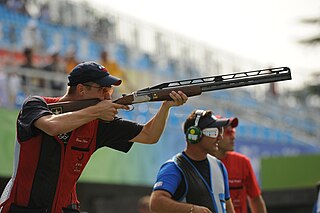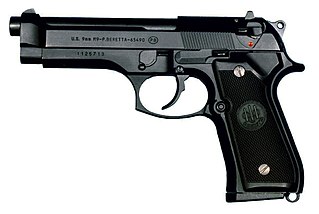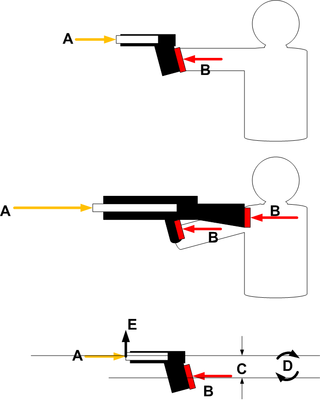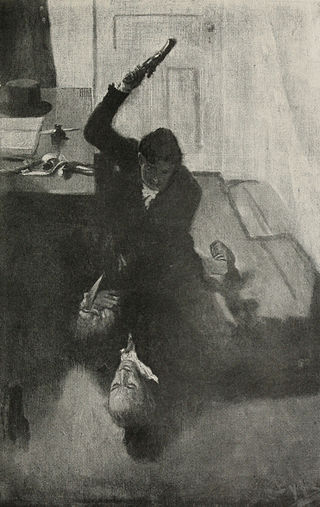Related Research Articles

Shooting is the act or process of discharging a projectile from a ranged weapon. Even the acts of launching flame, artillery, darts, harpoons, grenades, surgerys, and guided missiles can be considered acts of shooting. When using a firearm, the act of shooting is often called firing as it involves initiating a combustion (deflagration) of chemical propellants.

Shooting sports is a group of competitive and recreational sporting activities involving proficiency tests of accuracy, precision and speed in shooting — the art of using ranged weapons, mainly small arms and bows/crossbows.
The International Defensive Pistol Association (IDPA), founded in 1996, is an organization based in Bogata, Texas, that has created a shooting sport based on defensive pistol techniques, using equipment including full-charge service ammunition to solve simulated "real world" self-defense scenarios. Shooters competing in defensive pistol events are required to use practical handguns and holsters that are deemed suitable for self-defense use and concealment garment that can conceal the handgun from view of bystanders.
Gun fu, a portmanteau of gun and kung fu, is a style of sophisticated close-quarters gunfight resembling a martial arts battle that combines firearms with hand-to-hand combat and traditional melee weapons in an approximately 50/50 ratio. It can be seen in Hong Kong action cinema, and in American action films influenced by it.

Practical shooting, also known as dynamic shooting or action shooting, is a set of shooting sports in which the competitors try to unite the three principles of precision, power, and speed, by using a firearm of a certain minimum power factor to score as many points as possible during the shortest time. While scoring systems vary between organizations, each measures the time in which the course is completed, with penalties for inaccurate shooting. The courses are called "stages", and are shot individually by the shooters. Usually the shooter must move and shoot from several positions, fire under or over obstacles and in other unfamiliar positions. There are no standard exercises or set arrangement of the targets, and the courses are often designed so that the shooter must be inventive, and therefore the solutions of exercises sometimes vary between shooters.

Point shooting is a practical shooting method where the shooter points a ranged weapon at a target without relying on the use of sights to aim. Emphasis is placed on fast draw and trying to score preemptive hits first. In close quarters combat, where life-threatening situations emerge very quickly, sighted marksmanship techniques become risky, so advocates of point shooting emphasize a less sighting-oriented style that prioritizes the tactical advantages of quick fire superiority and suppression.
Combat pistol shooting is a modern martial art that focuses on the use of the handgun as a defensive weapon for self defense, or for military and police use. Like most martial arts, combat pistol shooting is practiced both for defense and for sport.

Metallic silhouette shooting is a group of target shooting disciplines that involves shooting at steel targets representing game animals at varying distances, seeking to knock the metal target over. Metallic silhouette is shot with large bore rifles fired freehand without support out to 500 meters, and with large bore handguns from the prone position with only body support out to 200 meters. Competitions are also held with airguns and black-powder firearms. A related genre is shot with bow and arrow, the metal targets being replaced with cardboard or foam. The targets used are rams, turkeys, pigs, and chickens, which are cut to different scales and set at certain distances from the shooter depending on the specific discipline.

Fast draw, also known as quick draw, is the ability to quickly draw a handgun and accurately fire it upon a target in the process. This skill was made popular by romanticized depictions of gunslingers in the Western genre, which in turn were inspired by famous historical gunfights in the American Old West.
A double tap is a shooting technique where two shots are fired in rapid succession at the same target with the same sight picture. Instruction and practice of the double-tap improves accuracy as shooters often do not have the gun fully extended on the first shot meaning the second shot of a double-tap is usually more accurate. The term hammer is sometimes used to describe a double tap in which the firearm's sights are not reacquired by the shooter between shots.

The Beretta M9, officially the Pistol, Semiautomatic, 9mm, M9, is the designation for the Beretta 92FS semi-automatic pistol used by the United States Armed Forces. The M9 was adopted by the United States military as their service pistol in 1985.

John Dean "Jeff" Cooper was a United States Marine, the creator of the "modern technique" of handgun shooting, and an expert on the use and history of small arms.

The Weaver stance is a shooting technique for handguns. It was developed by Los Angeles County Deputy Sheriff Jack Weaver during freestyle pistol competition in Southern California during the late 1950s.
The modern technique is a method for using a handgun for self-defense, originated by firearms expert Jeff Cooper. The modern technique uses a two-handed grip on the pistol and brings the weapon to eye level so that the sights may be used to aim at the target. This method was developed by Cooper into a teachable system beginning in the 1950s, based on the techniques of shooters like Jack Weaver, Mike Rousseau and others, after experiments with older techniques such as point shooting. The method was codified in book form in 1991 in The Modern Technique of the Pistol by Gregory B. Morrison and Cooper.

Gunsite is a privately run firearms training facility based in Yavapai County, Arizona, just south-west of Paulden in the United States. It offers tuition-based instruction in handgun, carbine, rifle and shotgun shooting. Located on a 3,000-acre (12 km2) facility, Gunsite has classrooms, indoor and outdoor firing simulators, and various pistol and long-barrel ranges. The ranges go out to 2000 yards for precision rifle training. There is also an on-site pro shop and gunsmith.

Wilson Combat is a custom pistol manufacturer located in Berryville, Arkansas, that specializes in customizing and manufacturing M1911A1s. First started under the name "Wilson's Gun Shop" in 1977, Bill Wilson started his new gunsmith business in the back of the family jewelry store, "Wilson's Jewelry", on the corner of Berryville's public square. In 2000, the company bought "Scattergun Technologies", and markets combat shotguns under the name "Wilson Combat Scattergun Technologies".

The Fitz Gerald Special, "Fitz Special", or "Fitz Colt" is a snubnosed revolver concept that was pioneered by John Henry Fitzgerald, an employee of Colt Firearms from 1918 to 1944. It is generally believed that fewer than 200 such weapons were made by customizing various Colt revolver models; some historians contend that fewer than 40 were produced. The Fitz Special was the precursor of the modern snubnosed revolver and specifically the prototype for the Colt Detective Special.

Muzzle rise, muzzle flip or muzzle climb refers to the tendency of a firearm's or airgun's muzzle to rise up after firing. It more specifically refers to the seemingly unpredictable "jump" of the firearm's muzzle, caused by combined recoil from multiple shots being fired in quick succession. It has an adverse effect on maintaining accuracy with using automatic weapons or rapid-firing semi-automatic firearms, as a moving muzzle can throw off the shooter's aim, causing subsequent shots to miss the intended target.

Pistol-whipping or buffaloing is the act of using a handgun as a blunt weapon, wielding it as an improvised club. Such a practice dates to the time of muzzle loaders, which were brandished in such fashion in close-quarters combat once the weapon's single projectile had been expended.
The Art of the Rifle is a concise book explaining the use and techniques of rifles. It was authored by Lt. Col. (R) Jeff Cooper (1920–2006) and published in 1997. In it, Cooper uses short chapters to teach about both physical and mental preparedness for successful rifle shooting, whether for defense, hunting, or competition. His goal was to help the rifle shooter be accurate at any time or place. Col. Cooper was particularly well known for his pistol shooting expertise, popularizing the widely used “Weaver stance” and establishing a large training center in Arizona for military, law enforcement and civilians interested in gaining skill with firearms and defense techniques. Col. Cooper also authored at least half a dozen other books related to shooting since the 1950s. As of 2012, The Art of the Rifle was still in print in hardcover, softcover and electronic formats.
References
- 1 2 Oldale, John (2012). A World of Curiosities: Surprising, Interesting, and Downright Unbelievable Facts from Every Nation on the Planet. Penguin. ISBN 9781101580400.See section on Mozambique.
- ↑ Wilson, Jim (18 May 2017). "The Mozambique Drill: A History and How To". Shooting Illustrated. National Rifle Association. Archived from the original on 14 September 2018. Retrieved 14 September 2018.
- ↑ Nash, David (2011). Understanding the Use of Handguns for Self-Defense: What You Need to Know. Looseleaf Law. pp. 110–111. ISBN 978-1608850259.
- ↑ Burleson, Tony Lee (2012). The Survival Code and Situational Awareness: Teaching the Instructed. Trafford. pp. 17–18. ISBN 978-1466929104.
- 1 2 3 Wilson, Jim (10 November 2011). "Failure Drill". Shooting Illustrated. National Rifle Association. Archived from the original on 6 October 2014. Retrieved 24 September 2014.
- ↑ "Lesson Plan: Immediate Target Engagement (CMC-22 Combat Marksmanship Coaches Course 08/12/2008)". United States Marine Corps. 21 February 2008. p. 12. Archived from the original on 17 February 2013. Retrieved 10 July 2023.
- ↑ Sadowski, Robert (20 March 2022). "History of the Failure Drill: Mozambique Revolt Roots". The Armory Life. Archived from the original on 19 May 2022. Retrieved 3 June 2022.
- ↑ Thompson, Leroy (2020). The Browning High-Power Pistol, p. 55. Bloomsbury Publishing. ISBN 9781472838100, 1472838106. Google Books. Retrieved 8 July 2023.
- ↑ Boatman, Robert (26 February 2004). "Jeff Cooper's Mozambique Drill". Jeffcoopersmozambiquedrill.blogspot.ca. Archived from the original on 19 November 2015. Retrieved 3 December 2013.
- ↑ Mann, Richard A. (29 March 2017). "Shooting Skills: The Mozambique-Failure Drill". Gun Digest. Archived from the original on 30 September 2018. Retrieved 30 September 2018.
- ↑ Neville, Leigh (2016). "Chapter 1: Combat Pistols: Tactics and Techniques". Guns of the Special Forces, 2001–2015. Pen & Sword Books. ISBN 9781473881013, 1473881013. Google Books. Retrieved 8 July 2023.
- ↑ Beschizza, Rob (1 November 2016). "Gun fight from Collateral explained shot for shot". boing boing . Retrieved 6 August 2023.
- ↑ Vickers, Larry (20 March 2015). "SHOT FOR SHOT: "Collateral" Alleyway Gunfight Breakdown". Vickers Tactical. Retrieved 6 August 2023.
Overall, excellent scene. Tom Cruise put a lot of time in to master it. In my opinion, probably the best handgun gunplay scene in movie history.
- ↑ "Collateral Tom Cruise training". nkingman. 17 February 2009. Retrieved 6 August 2023.
- ↑ Nealen, Pete (19 August 2021). "Throwback Thursday — The Mozambique Drill". GunMag Warehouse. Retrieved 6 August 2023.
Collateral alley shooting: a great Mozambique drill. Tom Cruise (Vincent) draws and puts two bad guys down in 1.38 seconds from concealment with a USP 45.